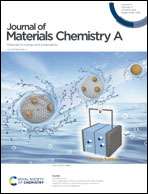Carbon nano-onion encapsulated cobalt nanoparticles for oxygen reduction and lithium-ion batteries†
Abstract
The design of novel catalytic materials towards sustainable energy production and storage is important for tackling energy shortage and environmental issues. Here, we report the preparation of cobalt nanoparticles encapsulated by a nitrogen doped carbon nano-onion (Co-NCNO) and their applications in the oxygen reduction reaction (ORR) and lithium-ion batteries (LIBs). Co-NCNO was prepared by one-step carbonization using an imidazolium ionic liquid as the carbon and nitrogen source. An in situ transmission electron microscope (in situ TEM) was used for the real time investigation of the carbon nano-onion formation process during a heating process from 450 °C to 850 °C. When applied to the ORR, Co-NCNO-850 exhibited high activity with a half-wave potential of 767 mV in 0.1 M KOH solution and high structural stability. Density functional theory (DFT) simulation indicates that the cobalt enhances the adsorption of reaction intermediates on the nitrogen doped carbon surface. Furthermore, Co-NCNO-850 also exhibited excellent performance for LIBs with a specific capacity of 774 mA h g−1 at a current density of 0.5C after 500 cycles. The ionic liquid assisted synthesis of Co-NCNO opens a new avenue for the efficient fabrication of hybrid nano-catalysts for energy applications.



 Please wait while we load your content...
Please wait while we load your content...